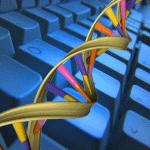Bioinformatics
|
11 august 2017 10:51:37 |
| Secondary structure and dynamics study of the intrinsically disordered silica-mineralizing peptide P5S3 during silicic acid condensation and silica decondensation (Proteins: Structure, Function, and Bioinformatics) |
|
Tweet The silica forming repeat R5 of sil1 from Cylindrotheca fusiformis was the blueprint for the design of P5S3, a 50-residue peptide which can be produced in large amounts by recombinant bacterial expression. It contains five protein kinase A target sites and is highly cationic due to 10 lysine and 10 arginine residues. In the presence of supersaturated orthosilicic acid P5S3 enhances silica-formation whereas it retards the dissolution of amorphous silica (SiO2) at globally undersaturated concentrations. The secondary structure of P5S3 during these two processes was studied by circular dichroism (CD) spectroscopy, complemented by nuclear magnetic resonance (NMR) spectroscopy of the peptide in the absence of silicate. The NMR studies of dual-labeled (13C, 15N) P5S3 revealed a disordered structure at pH 2.8 and 4.5. Within the pH range of 4.5 to 9.5 in the absence of silicic acid, the CD data showed a disordered structure with the suggestion of some polyproline II character. Upon silicic acid polymerization and during dissolution of preformed silica, the CD spectrum of P5S3 indicated partial transition into an ?-helical conformation which was transient during silica-dissolution. The secondary structural changes observed for P5S3 correlate with the presence of oligomeric/polymeric silicic acid, presumably due to P5S3-silica interactions. These P5S3-silica interactions appear, at least in part, ionic in nature since negatively charged dodecylsulfate caused similar perturbations to the P5S3 CD spectrum as observed with silica, while uncharged ß-D-dodecyl maltoside did not affect the CD spectrum of P5S3. Thus, with an associated increase in ?-helical character, P5S3 influences both the condensation of silicic acid into silica and its decondensation back to silicic acid. This article is protected by copyright. All rights reserved. |
| 148 viewsCategory: Biochemistry, Bioinformatics |
 Elucidation of Insulin Assembly at Acidic and Neutral pH: Characterization of Low Molecular Weight Oligomers (Proteins: Structure, Function, and Bioinformatics) Elucidation of Insulin Assembly at Acidic and Neutral pH: Characterization of Low Molecular Weight Oligomers (Proteins: Structure, Function, and Bioinformatics)Assessment of model accuracy estimations in CASP12 (Proteins: Structure, Function, and Bioinformatics) 
|
| blog comments powered by Disqus |
MyJournals.org
The latest issues of all your favorite science journals on one page
The latest issues of all your favorite science journals on one page



